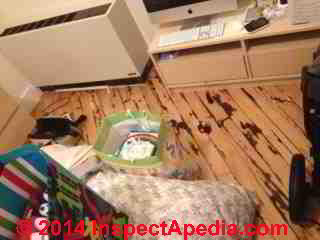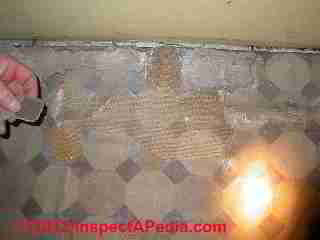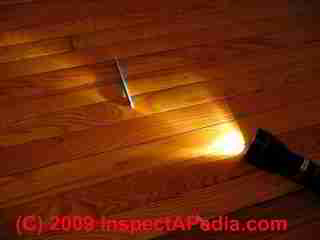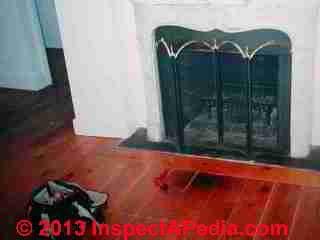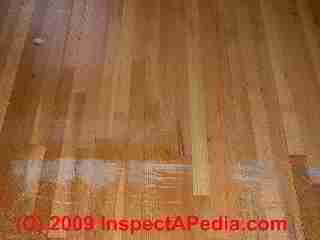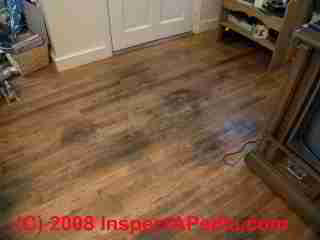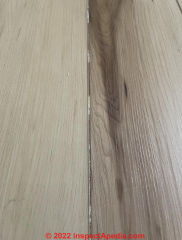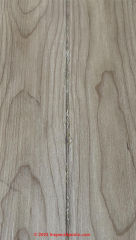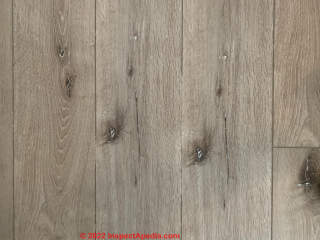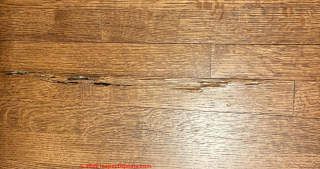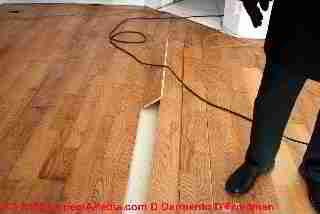 Guide to Types of Floor Damage & Defects
Guide to Types of Floor Damage & Defects
- POST a QUESTION or COMMENT about the causes & effects of flooring that is damaged or unsafe due to installation errors, poor maintenance, or other events.
Floor damage catalog: how to recognize the causes of different sorts of damage to floors.
Here we provide a catalog of types of damage found to flooring in buildings, such as improper installation, buckling, burns, cracks, loose, sloped, squeaky floors, mechanical damage, wear damage, water damage, and special kinds of damage found on wood floors.
We describe various causes of floor damage. We describe the wear and damage problems associated with different types of flooring materials such as carpeting, ceramic tile, vinyl or vinyl asbestos tile, resilient or sheet flooring, wood flooring.
InspectAPedia tolerates no conflicts of interest. We have no relationship with advertisers, products, or services discussed at this website.
- Daniel Friedman, Publisher/Editor/Author - See WHO ARE WE?
Floor Damage, Defects & Finish Problems
[Click to enlarge any image]
The following floor and flooring defect descriptions are adapted and expanded from original citations provided courtesy of Carson Dunlop Associates, Home Reference Book, with permission.
The damaged, stained floor shown at left is discussed in detail at WOOD FLOOR DAMAGE.
Article Contents
- APPLICATION ERRORS, CARPETING, TILE, WOOD
- BUCKLING WOOD OR WOOD LAMINATE FLOOR
- BURNS ON FLOORING
- CRACKED OR DAMAGED FLOOR TILES
- GAPS in RADIANT HEATED WOOD FLOORS - separate article - caused by running the radiant heat at too-high a temperature.
- LOOSE FLOORING & TRIP HAZARDS
- SLOPED FLOORS OUT OF LEVEL
- SQUEAKY NOISY FLOORS
- MECHANICAL DAMAGE & WEAR ON FLOORS
- WATER DAMAGE OR STAINS ON FLOORS
Application Errors, Carpeting, Tile, Vinyl Tile, Resilient or Sheet Linoleum or Vinyl or Wood Floors
Some ceramic tiles are intended for wall use only. When used on floors, they will wear quickly.
Ceramic tiles and softer clay or terracotta floor tiles are also broken, forming cut and trip hazards such as this floor (photo at left) we photographed in Barcelona, Spain.
The combination of broken ceramic tile risers and stair treads and a dark hallway are an invitation to a slip trip or fall accident in this building.
Carpet may be loose on stairs, a serious trip and fall hazard, not be laid flat or torn, more trip hazards, or wet, rotted, and moldy, health hazards.
Wood flooring may not be well secured, buckled, rotted, due to improper installation or lack of maintenance, or failure to act immediately following a spill or leak in the building.
Damaged Asbestos-Containing Floor Tiles, Sheet Flooring, Carpet Padding
Vinyl and vinyl asbestos tile floors and other resilient flooring such as linoleum or sheet vinyl may form trip hazards at tears and bulges or just plain disintegrate; some products contain asbestos and must be handled appropriately.
Tile and stone flooring may not be set properly or may be installed over inadequately stiff framing (leading to cracking). Grout may be poor quality or an incorrect type.
See details at ASBESTOS FLOORING IDENTIFICATION
A stunning snafu in the installation of tile flooring is described
at FLOOR RADIANT HEAT Mistakes to Avoid
where the builder failed to randomize the tiles, leading to ugly color blotch rectangles, failed to clean grout, leaving hazed ceramic floor tiles, and worst of all, failed to properly install radiant heating, leading
Buckling Wood or Wood Laminate Flooring
Improper floor installation can conspire with shifts in building moisture (or outright leaks) and temperature to cause severe buckling of wood floors and in some instances laminate flooring products as well.
Also failure to install a properly level and smooth underlayment or subfloor can cause uneven laminate floor surfaces.
See FLOOR WOOD, DAMAGE DIAGNOSIS for details.
For an explanation of wood board cupping and which side of deck, ramp, and exterior stair boards should face "up"
see BARK SIDE UP on DECKS & STEPS.
For a discussion of formaldehyde outgassing hazards from laminate wood flooring reported sold by Freight Liquidators (or possibly other vendors)
see FORMALDEHYDE in LAMINATE FLOORING
For an explanation of how high radiant heat temperatures can damage wood flooring
see GAPS in RADIANT HEATED WOOD FLOORS
Burn Marks on Flooring
Most types of flooring are susceptible to burns, with the exception of stone, terrazzo, ceramic and quarry tile. Common burns on finish flooring that we find include
- Burned resilient flooring under an overheating refrigerator compressor (vacuum the dust off of those coils!)
- Cigarette burns on wood or resilient flooring.
- Fireplace burns from heat or from coals or embers - possibly a fire hazard.
Cracked or Damaged Floor Tiles
The most common problem with brittle floor tiles is cracking. This is usually the result of a floor system that is not stiff enough to support the tile. Tiles can also be cracked by impact damage. Heavy items dropped on the tiles will sometimes crack or break them. Replacing individual tiles is not difficult, although color and grout matching may be a problem.
The sketch at left, showing alternative methods for installing and supporting ceramic tiles on floors is provided courtesy of Carson Dunlop Associates and appears in their Illustrated Home.
[Click to enlarge any image]
A cracked and broken concrete floor may only be a problem if it is not safe to walk across, or if there is moisture coming up through the floor. Since it is not a structural component, replacement of this floor is rarely a priority item.
Loose Flooring & Trip Hazards
Loose or missing sections of flooring should be replaced.
These areas may present a trip hazard. Carpet with ridges and buckles can be pulled tight to lie flat again by a carpet installer.
Sloped Floors out of Level
A concrete basement or crawl space floor that does not slope down to a floor drain can lead to water accumulation on the floor and resulting damage. Adding more concrete to an existing slab to improve the drainage slope is difficult, since new concrete does not usually bond well to old concrete.
A better solution may be to add another floor drain. This is expensive, because it requires breaking up some of the concrete floor. Replacing a deteriorated floor may be more cost effective than trying to repair or re-slope the floor.
Squeaky Noisy Floors
Squeaky wood floors are a nuisance, not a structural problem. A floor usually squeaks when walked on because the flooring finish or subfloor is not tightly secured. The subfloor may not be well-secured to the joists, or the finished flooring material (e.g. hardwood) may not be tightly fastened to the subfloor.
Flooring that is not tightly secured sits just above the support in some spots. When someone steps on the flooring in this area, it is pushed down onto its support. When the foot is taken off the floor, it springs back up. The squeaking is usually the result of the nails sliding in and out of the nail holes, or adjacent wood surfaces rubbing.
Mechanical Damage & Wear on Floor Finishes
When softwoods such as pine, fir or cedar are used as finish floorings, they can be damaged by high heeled shoes, for example. Furniture marking and denting is another common problem with softwood and resilient floors.
Softer materials, such as resilient flooring and carpet, will eventually wear out in high traffic areas. Sharp objects and furniture dropped or dragged across flooring may also damage the surface.
At FLOOR WOOD, DAMAGE DIAGNOSIS we discuss mechanical damage to flooring.
Water Damage or Stains on Floors
Common sources of water Damage/ damage include leaks from roofs, windows, doors and skylights, plumbing leaks (especially toilets and showers), leaks from hot water heating systems, and condensation.
At left the floor was damaged by pet urine, then re-finished or re-coated without removing the stains.
Aquariums, room humidifiers or dehumidifiers, over-watering of plants, melting snow and ice from boots, etc. can all cause water damage.
Wood-based floors may discolor, cup, buckle, warp or rot as a result of exposure to water. Carpet may develop mold. Flooring may be stained by water, food spills, improper cleaning, dirt, sunlight, or other factors.
See STAIN DIAGNOSIS on BUILDING INTERIORS and
Wood Floor Damage Diagnosis
Details about types of damage to wood flooring are provided separately at FLOOR WOOD, DAMAGE DIAGNOSIS.
...
Reader Comments, Questions & Answers About The Article Above
Below you will find questions and answers previously posted on this page at its page bottom reader comment box.
Reader Q&A - also see RECOMMENDED ARTICLES & FAQs
On 2022-01-30 by Inspectapedia Com Moderator - kitchen flooring laid off center
@Dave,
This sounds like an installation aesthetics topic unless you're telling me that the floor is actually damaged in some way.
If that were my floor and I were concerned that it didn't seem to align correctly with the walls, I would make some careful measurements first to see whether or not the room is out of square.
Quite obviously if the room is not square then the flooring cannot align perfectly with all of the walls.
On 2022-01-29 by Dave
Our engineered floor has been laid off centre. Is there any tolerances on this as the difference is 35mm from one end of the kitchen to the other over a 5 metre kitchen. The entire floor has been laid about 10 degrees off centre.
On 2021-10-22 by inspectapedia.com.moderator - how can I change the wrong color putty used to fill screw holes?
@R Jones,
Try carefully drilling out the mismatched putty and test some that is the right color
On 2021-10-22 by R Jones
Supposed carpenter said he could get rid of squeaks in our hardwood flooring. He's done work for us before so we trusted him. He used a ton of "Squeak No More screws about an inch to inch and 1/2 apart in the seam spaces between the boards then filled to holes with a putty too light in color.
Will those whole areas have to be pulled up and replaced as I assume there is no way to get those screws out after the tops are broken off?
On 2021-07-28 by inspectapedia.com.moderator - use moisture meter to investigate floor moisture problem
@Gianni,
The photo is not quite sharp enough for me to be sure, but in trying to zoom in on your images it looks to me as if there may be a moisture problem under this floor, and you may be seeing the result of that as damaged flooring or even a fluorescence seeping up at joints.
You could try doing some investigating with a moisture meter, and you could also investigate the history of any spills on to or water entry below the flooring.
On 2021-07-28 by Gianni
We installed smart core wood laminate flooring and noticed that in high traffic areas the floor look bad and the creases look bad. Looking forward some assistance
On 2021-06-04 by inspectapedia.com.moderator
@Cami,
Let's start with a point of clarification. If this is a vinyl floor then it's surface isn't painted but it may indeed have a very thin vinyl skin that imparts the color and texture.
In diagnosing the color or material loss that you mention I would look for the wear pattern to see if it's related to foot traffic and raised areas in the flooring and I would look at it under magnification to see exactly how the material has come off.
While this is by no means an authoritative opinion I would bet that the manufacturer will consider your complaint to be normal wear and tear. And it may be normal for their product.
On 2021-06-03 by Cami
I had lifetime vinyl flooring installed in December. It is Dynamic Hardcore 3DGE Shoal and the painted beveled edge is flaking up and trying to find out what is causing it. Personally I think it’s a defect in the painted edge and trying to find out if this is a common issue with this type of floor.
On 2021-03-09 by danjoefriedman (mod) - smaller visible termite damage may indicate much more extensive damage
@PHO,
You can be certain that if the termite damage is bad enough to come up through the finished surface of the floor, there is a good chance that it is long standing and quite extensive.
IF the building was successfully treated for wood destroying insects, then yes, they may not be active; but there is likely to be substantial hidden damage.
On 2021-03-08 by PHO
Pls see pics. Inspector said termites? Only 3 spots in whole floor and this is by far the worst.... others are just minor slits in wood. These have been in wood for awhile and havent gotten worse.
On 2020-10-16 - by (mod) -
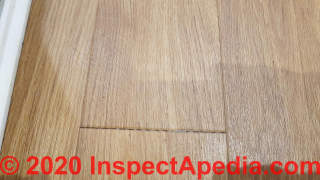 Chris:
Chris:
Thank you for the helpful question about LVF flooring gaps and ridges: cause and (not so likely) cure.
I've seen this gap and ridge problem on most types of manufactured as well as other types of wood and plank and vinyl or engineered flooring, caused usually by temperature and humidity changes and occasionally by installation errors such as failure to leave a bit of space around the floor perimeter.
Let's compare the manufacturer's flooring installation instructions with what you know about your floor's installation to see if we can be more-specific. All of the warnings given below, excerpted from the Amitco Spacia installation instructions warn of conditions that might cause the gaps or ridge that you mention.
Take a look at the AMITCO SPACIA FLOORING INSTALLATION INSTRUCTIONS [PDF]
Here are a couple of examples to consider:
Mannington LVF flooring should remain at a temperature between 55°-85° F (13°-29° C) during its service life.
MATERIAL RECEIVING, HANDLING & STORAGE
1. All floor covering products require care during storage and handling. It is important to store flooring products in a dry, temperature-controlled interior area.
2. The temperature range should be between 65º F and 100º F, and the relative humidity should be controlled and maintained between 30% to 70%.
3. Material must be conditioned for at least 48 hours before beginning the installation.
4. Flooring materials that are shipped in cartons must also be stored properly. Cartons must be kept squarely positioned on the pallet to prevent distortion of the contents and to be fully supported. Do not store close to exterior walls, in direct sunlight or near HVAC vents
and
1. Before jobsite testing, the building envelope must be sealed (walls, roofing, windows, doorways etc., installed).
2. The installation area and materials to be installed shall be maintained at a minimum of 65°F (18.3°C) and a maximum of 85°F (29.4°C) for 48 hours before, during and for 48 hours after completion of the installation. Relative humidity level extremes should also be avoided.
General recommended humidity control level is between 35 – 55 %.
If a system other than the permanent HVAC source is utilized, it must provide proper control of both temperature and humidity to recommended or specific levels for the appropriate time duration.
You can also contact Mannington Technical Services at 800 241 2262 Ext. 3 or visit www.manningtoncommercial.com
On 2020-10-16 by Chris parker
Picture [above]
I have had an Amtico spacia fitted in a kitchen diner. Gaps have appeared between the plants some credit card size . A small ridge exists in the floor where the wall was removed. This has made the floor not level for a small part.
On 2016-08-29 by (mod)
I'd check different areas of the flooring that have or have not been treated with the cleaners you've tried and for moisture level. If the floor surface was damaged by a cleaner containing a solvent, the resulting gummy top surface may not recover very well.
On 2016-08-28 by Nona
I have a newer vinyl floor. Not even 5 years old. I can't figure out why it has become sticky. We have air conditioners to help with humidity. And I mop the floor regularly. But even right after mopping the floor is sticky. Any ideas. I am used get an all purpose cleaner in water. I have also rinsed it with straight water.
...
Continue reading at NON-RESILIENT FLOORING or select a topic from the closely-related articles below, or see the complete ARTICLE INDEX.
Suggested citation for this web page
Continue reading at FLOOR WOOD, DAMAGE DIAGNOSIS or select a topic from the closely-related articles below, or see the complete ARTICLE INDEX.
Or see these
Recommended Articles
- ANIMAL STAINS & MARKS in BUILDINGS - and how to get rid of them (the stains not the animals)
- ASBESTOS FLOORING IDENTIFICATION
- CARPET MOLD / ODOR TESTS
- CARPET PADDING ASBESTOS, MOLD, ODORS
- CARPET STAIN DIAGNOSIS
- FLOOR, CONCRETE SLAB CHOICES
- STAIN DIAGNOSIS on BUILDING INTERIORS
- STAINS on INDOOR SURFACES, PHOTO GUIDE
- WATER DAMAGED BATHROOM FLOOR REPAIR
- WOOD FLOOR DAMAGE DIAGNOSIS & CURE
Suggested citation for this web page
FLOOR DAMAGE DIAGNOSIS at InspectApedia.com - online encyclopedia of building & environmental inspection, testing, diagnosis, repair, & problem prevention advice.
Or see this
INDEX to RELATED ARTICLES: ARTICLE INDEX to BUILDING FLOORING
Or use the SEARCH BOX found below to Ask a Question or Search InspectApedia
Or see
INDEX to RELATED ARTICLES: ARTICLE INDEX to BUILDING INTERIORS
Or use the SEARCH BOX found below to Ask a Question or Search InspectApedia
Ask a Question or Search InspectApedia
Questions & answers or comments about the causes & effects of flooring that is damaged or unsafe due to installation errors, poor maintenance, or other events. .
Try the search box just below, or if you prefer, post a question or comment in the Comments box below and we will respond promptly.
Search the InspectApedia website
Note: appearance of your Comment below may be delayed: if your comment contains an image, photograph, web link, or text that looks to the software as if it might be a web link, your posting will appear after it has been approved by a moderator. Apologies for the delay.
Only one image can be added per comment but you can post as many comments, and therefore images, as you like.
You will not receive a notification when a response to your question has been posted.
Please bookmark this page to make it easy for you to check back for our response.
IF above you see "Comment Form is loading comments..." then COMMENT BOX - countable.ca / bawkbox.com IS NOT WORKING.
In any case you are welcome to send an email directly to us at InspectApedia.com at editor@inspectApedia.com
We'll reply to you directly. Please help us help you by noting, in your email, the URL of the InspectApedia page where you wanted to comment.
Citations & References
In addition to any citations in the article above, a full list is available on request.
- Mark Cramer Inspection Services Mark Cramer, Tampa Florida, Mr. Cramer is a past president of ASHI, the American Society of Home Inspectors and is a Florida home inspector and home inspection educator. Mr. Cramer serves on the ASHI Home Inspection Standards. Contact Mark Cramer at: 727-595-4211 mark@BestTampaInspector.com
- Pergo AB, division of Perstorp AB, is a Swedish manufacturer or modern laminate flooring products. Information about the U.S. company can be found at http://www.pergo.com where we obtained historical data used in our discussion of the age of flooring materials in buildings.
- Manufactured & Modular Homes: Modular Building Systems Association, MBSA, modularhousing.com, is a trade association promoting and providing links to contact modular builders in North America. Also see the Manufactured Home Owners Association, MHOAA, at www.mhoaa.us. The Manufactured Home Owners Association of America is a National Organization dedicated to the protection of the rights of all people living in Manufactured Housing in the United States.
- In addition to citations & references found in this article, see the research citations given at the end of the related articles found at our suggested
CONTINUE READING or RECOMMENDED ARTICLES.
- Carson, Dunlop & Associates Ltd., 120 Carlton Street Suite 407, Toronto ON M5A 4K2. Tel: (416) 964-9415 1-800-268-7070 Email: info@carsondunlop.com. Alan Carson is a past president of ASHI, the American Society of Home Inspectors.
Thanks to Alan Carson and Bob Dunlop, for permission for InspectAPedia to use text excerpts from The HOME REFERENCE BOOK - the Encyclopedia of Homes and to use illustrations from The ILLUSTRATED HOME .
Carson Dunlop Associates provides extensive home inspection education and report writing material. In gratitude we provide links to tsome Carson Dunlop Associates products and services.


